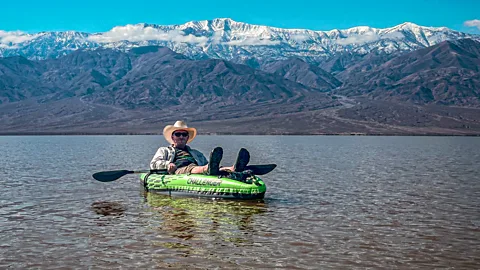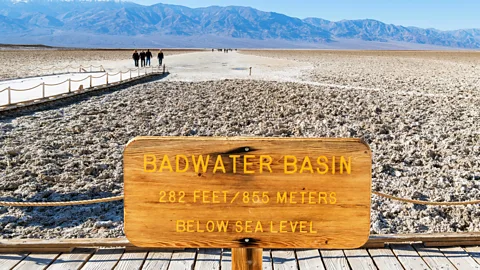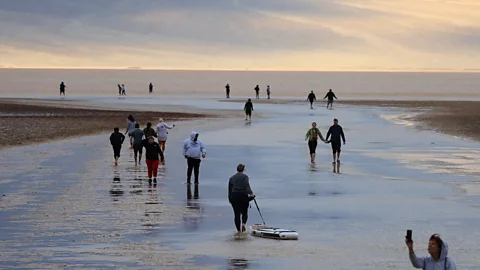Death Valley, where an ancient lake has re-emerged in the US' driest place
 Center for Biological Diversity
Center for Biological DiversityFollowing record-setting rainfall, kayakers are flocking to Death Valley to experience a rare opportunity.
Just before sunrise on 19 February, Patrick Donnelly headed to Badwater Basin in California's Death Valley National Park to take photographs. As the lowest point in North America, the basin is normally a surreal expanse of parched salt flats stretching as far as the eye can see. But on this day, what the longtime area resident saw as he approached took his breath away.
"I said to myself, 'Oh my god, this is incredible,'" said Donnelly, who is the Great Basin director for the Center for Biological Diversity. "[Death Valley] is the hottest, driest place in North America, and all of a sudden, it literally has billions of gallons of water. It has been completely transformed."
Badwater Basin, which lies at the very bottom of Death Valley, is the remnant of a vast ancient lake that once existed tens of thousands of years ago. It normally averages a paltry 2in (5.08cm) of rain each year. But during the past six months, the valley floor has received nearly 5in (12.7 cm). According to the National Park Service, most of that rain came from two events: 2.2in (5.59 cm) back on 20 August and another 1.5in (3.81cm) during the record-setting "atmospheric rivers" that have recently drenched much of California.
Rain generally evaporates very quickly in Death Valley, but the billions of gallons of water that Donnelly witnessed is now a six-mile-long by three-mile-wide lake known as Lake Manly. A stunning series of satellite images captured by NASA, which contrast the desert basin before and after the recent rains, show a sapphire-blue body of water surrounded by miles of arid, barren mountains and desert dunes.
 Alamy
AlamyWith repeated rain soaking the area, the lake has also grown to be about 1ft (0.3m) deep, which means there's just enough water to allow an activity that sounds curiously out of place in Death Valley's famously parched landscape: kayaking.
"As soon as we got there the other day, we turned around and went back into town as fast as we could to buy inflatable kayaks," said Donnelly.
The drive from Badwater Basin back to the nearest town – Pahrump, Nevada – is an 80-mile haul. But once there, Donnelly purchased an inflatable kayak and drove all the way back to the ephemeral Lake Manly to spend the next few hours enjoying the rare kayaking opportunity that had just emerged amid the desert.
"It was perfectly clear and still," said Donnelly. "The sun was glittering off of the water. It was incredibly beautiful."
The return of an ancient lake
The ancient lake at Badwater Basin, which lies 282ft (85.95m) below sea level, evaporated tens of thousands of years ago – long before the so-called 1849-ers arrived in California to pan for gold. After the prehistoric lake's disappearance, the landscape accumulated sediment and concentrated salt deposits, which resulted in the basin's unique and often-photographed pattern of geometric salt polygons.
The last time in modern memory that the basin filled with such a long-lasting body of water was about two decades ago, according to Elyscia Letterman, an interpretive park ranger with the National Park Service. "We do have photographs of the lake from 2004 or 2005 when it was similarly flooded," she explained.
But two decades is a long wait for the reappearance of an extinct lake in a scorched landscape, where temperatures are known to top 120F (49C) in the shade. Tourists have wasted no time making the most of this remarkable occurrence. In addition to kayaking, visitors are happily setting up beach chairs and children in swimsuits have been spotted taking a dip in the newly formed body of water.
 Getty Images
Getty ImagesIs Lake Manly here to stay?
How long is all of this water-related activity likely to last in Death Valley? Unfortunately, the experience is expected to be fleeting.
"It's evaporating rapidly," said Letterman. "We're not sure how long it will stick around, but it is disappearing."
The lake may only remain deep enough to allow kayaking for just a few more weeks, Letterman added. But even after the lake becomes too shallow to kayak, it's likely that at least a small amount of water will remain in the basin – just enough to still offer photographers and visitors some very unique images at least through April.
"It's quite beautiful, especially at sunrise and sunset when you have these beautiful reflections from the mountains around the lake," said Letterman. "There's some snow on the mountaintops. So, the reflection of the snow-capped mountains on the water is very beautiful."
"It doesn't feel like you're in Death Valley," Letterman added.
As for Donnelly, whether it's a few days or a few weeks, he intends to make the most of the lake's presence in Death Valley. He planned to head out there again this week and over the weekend as well.
"This is something I want to experience as much as I can," he said. After all, "it's likely to be a once-in-a-lifetime thing".
--
Join more than three million BBC Travel fans by liking us on Facebook, or follow us onTwitter and Instagram.
If you liked this story,sign up for The Essential List newsletter – a handpicked selection of features, videos and can't-miss news delivered to your inbox every Friday.
